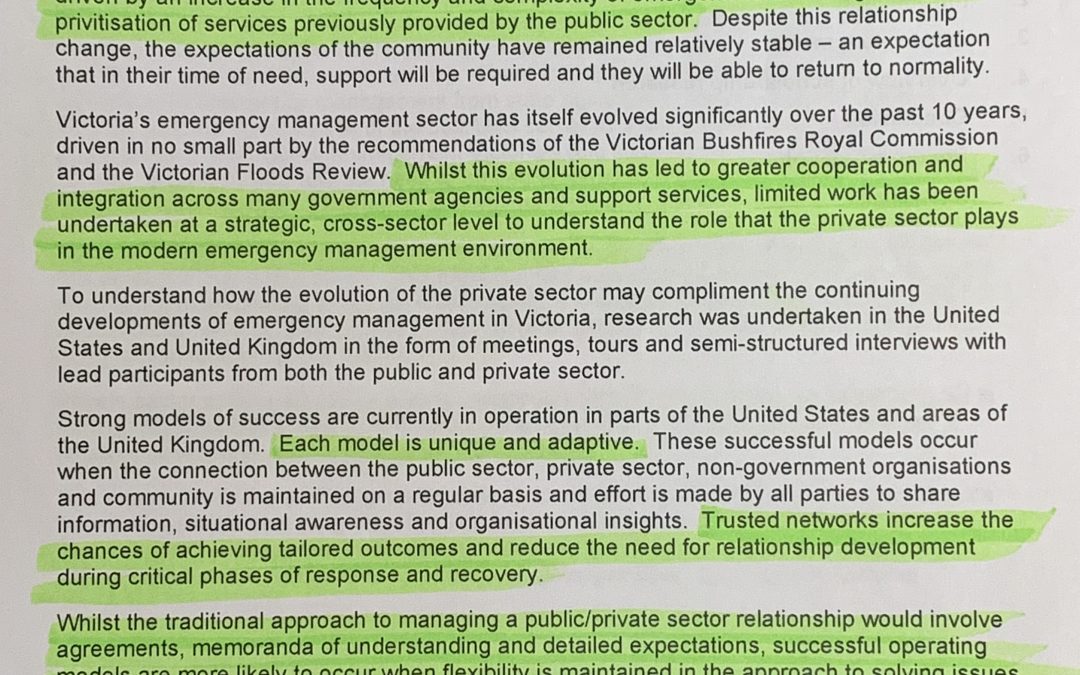This blog is aimed at emergency services organisations… because they’re businesses too!
Recently, I connected with Luke Heagarty from CFA to learn about his trip to the UK and US. Luke won a 2018 Emergency Services Foundation Scholarship to look at ‘Incident Management with the Private Sector’.
While much of my focus is on government, businesses and communities, the emergency service organisations (who are businesses too mind you) also stand to benefit greatly by thinking differently and doing differently.
Meeting Luke has confirmed to me the clear benefits associated with educating and connecting ESO’s and the private sector, collectively.
Here are some key takeaways from Luke’s report (available here)
1. Trusted networks increase the chances of achieving tailored outcomes and reduce the need for relationship development during critical phases of response and recovery.
Connections build resilience.
If you are connected BEFORE something happens then you’ll know who to call (because their name and number will already be in your phone), you’ll know what they may need from you and what you can provide to them (because you’ve already connected to have the conversation about capabilities, needs and vulnerabilities) so you’re already streets ahead from those who are introducing themselves amongst the chaos.
Most importantly, connecting before and building networks enables you to build trust. So you will have already identified who you can rely on during the tough times ahead.
With an obvious level of mistrust traditionally between emergency services and private sector, imagine what may come out of connecting beforehand with key business leaders and seeing what might be possible?
2. Private sector entities have a large untapped potential to help provide skilled services in the form of technical manpower or in-kind donations of goods or services for preparedness & emergency response phases of disaster management.
Businesses operate every day to deliver products and services to its customers and consumers. There is a plethora of opportunities for emergency service organisations to collaborate and co-design mutually beneficial outcomes that deliver tangible community benefits.
Today’s private sector operates within a world of expectations from its stakeholder groups – employees, shareholders, suppliers, customers all expect businesses to do the right thing. As a result its never been a better time for emergency services organisation to consider what their needs and capabilities are to better support communities.
The share value partnership opportunities between these two groups are big, but it’ll take pioneers like Luke to drive them into reality.
3. Successful operating models are more likely to occur when flexibility is maintaind in the approach to solving issues.
This is perhaps my favourite statement from Luke. Because while many within the emergency management sector work to strict processes and policies, when determining relationships and how to engage with the private sector, flexibility is key.
You don’t need to go into a water tight procurement agreement with a private sector organisation. There are great examples from the US and UK of flexible and adaptable MOU’s that are established ready for if a particicular level of support or partnership is needed.
By understanding the different types of partnership opportunities, better relationships for before, during and after can be developed (and maintained).
4. A step towards developing meaningful and successful relationships with the private sector may not be as big (or challenging) as some would expect. There is an opportunity… to embrace the benefits of such a relationship and integrate it ito our evolving emergency management environment.
Luke states that the relationship between the public and private sector has evolved over the last 40 years, driven by an increase in the frequency and complexity of emergencies and the growing privatistion of services previously provided by the private sector.
He says in Victoria, the evolution within the sector has led to greater cooperation and integration across many government agencies and support services, yet limited work has been undertaken at a strategic, cross-sector level to understand the role that the private sector plays in the modern emergency management environment.
I totally agree, and see this as one of the biggest opportunities for C2C.
Bringing together public and private stakeholder groups to have a better understanding of each other’s capabilities, needs, vulnerabilities while discussing roles and responsibilities is exactly why we developed the CIX Workshops + Simulation Exercise program – which is just as relevant for ESO’s to participate in as private sector organisations.
Because if we are not connecting, then we cannot work together to drive positive solutions.
I highly recommend reading Luke’s findings – and I’m excited to continue seeking opportunities with peers like Luke that bring public and private opportunities to reality.
Make sure you connect if you’re looking for a way of #doingdisastersdifferently.
_____________________________________________________________________________________________
Renae Hanvin brings to businesses (of all shapes and sizes) a unique understanding of connecting corporate capabilities to community needs – before, during and after disasters. With a personal commitment to educate, connect and motivate businesses to support the communities in which they operate, Renae proudly leads a national team of best practice emergency sector and community relations specialists.
To become a business leader in building a disaster resilient Australia, visit www.corporate2community.com


Recent Comments